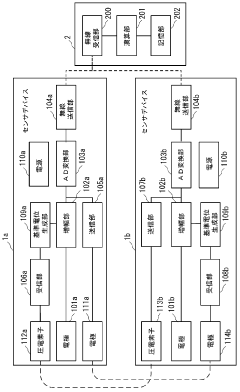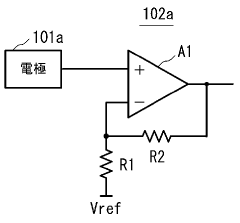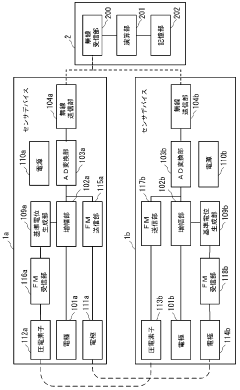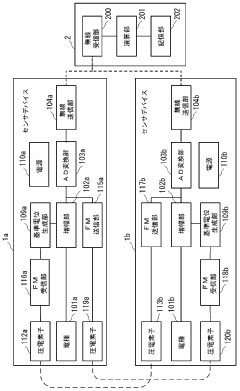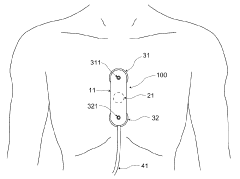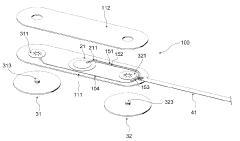Tracking Bio-signals with Piezoelectric Mechanisms
JUL 17, 20259 MIN READ
Generate Your Research Report Instantly with AI Agent
Patsnap Eureka helps you evaluate technical feasibility & market potential.
Piezoelectric Biosensing: Background and Objectives
Piezoelectric biosensing represents a cutting-edge approach in the field of biomedical engineering, leveraging the unique properties of piezoelectric materials to detect and monitor biological signals. This technology has evolved significantly over the past few decades, driven by the increasing demand for non-invasive, real-time health monitoring solutions.
The fundamental principle behind piezoelectric biosensing lies in the ability of certain materials to generate an electric charge in response to applied mechanical stress. This phenomenon, known as the piezoelectric effect, was first discovered by Jacques and Pierre Curie in 1880. Since then, it has found applications in various fields, with biosensing emerging as a particularly promising area.
In the context of tracking bio-signals, piezoelectric mechanisms offer several advantages over traditional sensing methods. They provide high sensitivity, rapid response times, and the ability to operate without external power sources. These characteristics make them ideal for continuous, long-term monitoring of physiological parameters such as heart rate, respiratory rate, and muscle activity.
The evolution of piezoelectric biosensing has been closely tied to advancements in materials science and nanotechnology. Early piezoelectric sensors were primarily based on bulk materials like quartz and lead zirconate titanate (PZT). However, recent years have seen a shift towards nanoscale piezoelectric materials, including zinc oxide nanowires and polyvinylidene fluoride (PVDF) nanofibers, which offer enhanced sensitivity and flexibility.
The primary objective of piezoelectric biosensing research is to develop robust, reliable, and user-friendly devices capable of accurately tracking various bio-signals in real-time. This includes improving sensor sensitivity, enhancing signal-to-noise ratios, and developing advanced data processing algorithms to interpret complex biological signals.
Another key goal is the integration of piezoelectric sensors into wearable and implantable devices. This presents unique challenges related to biocompatibility, power efficiency, and miniaturization. Researchers are exploring novel materials and fabrication techniques to address these issues, aiming to create seamless, unobtrusive sensing solutions that can be easily incorporated into everyday life.
The future trajectory of piezoelectric biosensing is likely to focus on expanding the range of detectable bio-signals and improving the accuracy and reliability of measurements. This may involve the development of multi-modal sensing platforms that combine piezoelectric sensors with other sensing modalities, such as optical or electrochemical sensors, to provide a more comprehensive picture of an individual's health status.
The fundamental principle behind piezoelectric biosensing lies in the ability of certain materials to generate an electric charge in response to applied mechanical stress. This phenomenon, known as the piezoelectric effect, was first discovered by Jacques and Pierre Curie in 1880. Since then, it has found applications in various fields, with biosensing emerging as a particularly promising area.
In the context of tracking bio-signals, piezoelectric mechanisms offer several advantages over traditional sensing methods. They provide high sensitivity, rapid response times, and the ability to operate without external power sources. These characteristics make them ideal for continuous, long-term monitoring of physiological parameters such as heart rate, respiratory rate, and muscle activity.
The evolution of piezoelectric biosensing has been closely tied to advancements in materials science and nanotechnology. Early piezoelectric sensors were primarily based on bulk materials like quartz and lead zirconate titanate (PZT). However, recent years have seen a shift towards nanoscale piezoelectric materials, including zinc oxide nanowires and polyvinylidene fluoride (PVDF) nanofibers, which offer enhanced sensitivity and flexibility.
The primary objective of piezoelectric biosensing research is to develop robust, reliable, and user-friendly devices capable of accurately tracking various bio-signals in real-time. This includes improving sensor sensitivity, enhancing signal-to-noise ratios, and developing advanced data processing algorithms to interpret complex biological signals.
Another key goal is the integration of piezoelectric sensors into wearable and implantable devices. This presents unique challenges related to biocompatibility, power efficiency, and miniaturization. Researchers are exploring novel materials and fabrication techniques to address these issues, aiming to create seamless, unobtrusive sensing solutions that can be easily incorporated into everyday life.
The future trajectory of piezoelectric biosensing is likely to focus on expanding the range of detectable bio-signals and improving the accuracy and reliability of measurements. This may involve the development of multi-modal sensing platforms that combine piezoelectric sensors with other sensing modalities, such as optical or electrochemical sensors, to provide a more comprehensive picture of an individual's health status.
Market Analysis for Piezoelectric Biosignal Devices
The market for piezoelectric biosignal devices is experiencing significant growth, driven by increasing demand for non-invasive health monitoring solutions and advancements in wearable technology. This sector encompasses a wide range of applications, including heart rate monitoring, sleep tracking, and stress management. The global market for these devices is projected to expand at a compound annual growth rate of over 10% in the coming years.
Consumer health awareness and the growing trend of personalized healthcare are key factors fueling market growth. Individuals are increasingly seeking ways to monitor their vital signs and overall well-being outside traditional healthcare settings. This shift towards proactive health management has created a robust demand for user-friendly, accurate, and portable biosignal monitoring devices.
The healthcare industry represents a major market segment for piezoelectric biosignal devices. Hospitals and clinics are adopting these technologies to improve patient monitoring capabilities and enhance the efficiency of healthcare delivery. Remote patient monitoring, enabled by piezoelectric sensors, allows healthcare providers to track patients' vital signs continuously, reducing the need for frequent in-person visits and enabling early intervention in case of health anomalies.
Sports and fitness applications form another significant market segment. Athletes and fitness enthusiasts are using piezoelectric biosignal devices to optimize their training regimens and monitor their physical performance. These devices provide real-time data on heart rate, respiratory rate, and other physiological parameters, allowing users to tailor their workouts for maximum effectiveness and safety.
The elderly care sector is emerging as a promising market for piezoelectric biosignal devices. With aging populations in many countries, there is a growing need for technologies that can monitor the health status of older adults and alert caregivers to potential health issues. Piezoelectric sensors integrated into wearable devices or even furniture and bedding can provide non-intrusive monitoring of vital signs and movement patterns.
Geographically, North America and Europe currently lead the market for piezoelectric biosignal devices, owing to high healthcare expenditure, technological advancements, and greater consumer awareness. However, the Asia-Pacific region is expected to witness the fastest growth in the coming years, driven by improving healthcare infrastructure, rising disposable incomes, and increasing adoption of wearable health technologies.
Challenges in the market include concerns over data privacy and security, as these devices collect sensitive health information. Additionally, ensuring the accuracy and reliability of measurements across diverse user populations remains a technical hurdle. Despite these challenges, the market for piezoelectric biosignal devices is poised for continued expansion, supported by ongoing technological innovations and the growing emphasis on preventive healthcare.
Consumer health awareness and the growing trend of personalized healthcare are key factors fueling market growth. Individuals are increasingly seeking ways to monitor their vital signs and overall well-being outside traditional healthcare settings. This shift towards proactive health management has created a robust demand for user-friendly, accurate, and portable biosignal monitoring devices.
The healthcare industry represents a major market segment for piezoelectric biosignal devices. Hospitals and clinics are adopting these technologies to improve patient monitoring capabilities and enhance the efficiency of healthcare delivery. Remote patient monitoring, enabled by piezoelectric sensors, allows healthcare providers to track patients' vital signs continuously, reducing the need for frequent in-person visits and enabling early intervention in case of health anomalies.
Sports and fitness applications form another significant market segment. Athletes and fitness enthusiasts are using piezoelectric biosignal devices to optimize their training regimens and monitor their physical performance. These devices provide real-time data on heart rate, respiratory rate, and other physiological parameters, allowing users to tailor their workouts for maximum effectiveness and safety.
The elderly care sector is emerging as a promising market for piezoelectric biosignal devices. With aging populations in many countries, there is a growing need for technologies that can monitor the health status of older adults and alert caregivers to potential health issues. Piezoelectric sensors integrated into wearable devices or even furniture and bedding can provide non-intrusive monitoring of vital signs and movement patterns.
Geographically, North America and Europe currently lead the market for piezoelectric biosignal devices, owing to high healthcare expenditure, technological advancements, and greater consumer awareness. However, the Asia-Pacific region is expected to witness the fastest growth in the coming years, driven by improving healthcare infrastructure, rising disposable incomes, and increasing adoption of wearable health technologies.
Challenges in the market include concerns over data privacy and security, as these devices collect sensitive health information. Additionally, ensuring the accuracy and reliability of measurements across diverse user populations remains a technical hurdle. Despite these challenges, the market for piezoelectric biosignal devices is poised for continued expansion, supported by ongoing technological innovations and the growing emphasis on preventive healthcare.
Current Challenges in Piezoelectric Biosensing
Piezoelectric biosensing technology has made significant strides in recent years, yet several challenges persist in its widespread adoption and effectiveness. One of the primary obstacles is the inherent sensitivity of piezoelectric materials to environmental factors such as temperature fluctuations and humidity. These external influences can lead to signal drift and reduced accuracy in bio-signal tracking, necessitating complex compensation mechanisms.
Another significant challenge lies in the miniaturization of piezoelectric biosensors while maintaining their sensitivity and reliability. As the demand for wearable and implantable devices grows, reducing the size of sensors without compromising performance becomes crucial. This miniaturization process often leads to decreased signal-to-noise ratios, making it difficult to detect subtle bio-signals accurately.
The biocompatibility of piezoelectric materials used in biosensing applications presents another hurdle. While some materials like polyvinylidene fluoride (PVDF) have shown promise, finding materials that are both highly piezoelectric and safe for long-term contact with biological tissues remains a challenge. This is particularly critical for implantable devices where the sensor must function reliably over extended periods without causing adverse reactions.
Power consumption is an ongoing concern in piezoelectric biosensing. Although piezoelectric materials can generate electricity from mechanical stress, many biosensing applications require additional power for signal processing and data transmission. Developing energy-efficient systems that can operate for extended periods, especially in implantable devices, is a key area of focus for researchers.
The integration of piezoelectric sensors with flexible and stretchable substrates poses another challenge. While flexibility is crucial for conforming to body contours and ensuring comfort in wearable applications, it can affect the stability and consistency of sensor readings. Developing robust fabrication techniques that maintain sensor performance under various deformation conditions is an active area of research.
Lastly, the challenge of signal processing and interpretation in complex biological environments cannot be overstated. Bio-signals are often weak and can be masked by noise from various sources, including motion artifacts and electromagnetic interference. Developing advanced algorithms and signal processing techniques to extract meaningful data from these complex signals remains a significant challenge in piezoelectric biosensing.
Another significant challenge lies in the miniaturization of piezoelectric biosensors while maintaining their sensitivity and reliability. As the demand for wearable and implantable devices grows, reducing the size of sensors without compromising performance becomes crucial. This miniaturization process often leads to decreased signal-to-noise ratios, making it difficult to detect subtle bio-signals accurately.
The biocompatibility of piezoelectric materials used in biosensing applications presents another hurdle. While some materials like polyvinylidene fluoride (PVDF) have shown promise, finding materials that are both highly piezoelectric and safe for long-term contact with biological tissues remains a challenge. This is particularly critical for implantable devices where the sensor must function reliably over extended periods without causing adverse reactions.
Power consumption is an ongoing concern in piezoelectric biosensing. Although piezoelectric materials can generate electricity from mechanical stress, many biosensing applications require additional power for signal processing and data transmission. Developing energy-efficient systems that can operate for extended periods, especially in implantable devices, is a key area of focus for researchers.
The integration of piezoelectric sensors with flexible and stretchable substrates poses another challenge. While flexibility is crucial for conforming to body contours and ensuring comfort in wearable applications, it can affect the stability and consistency of sensor readings. Developing robust fabrication techniques that maintain sensor performance under various deformation conditions is an active area of research.
Lastly, the challenge of signal processing and interpretation in complex biological environments cannot be overstated. Bio-signals are often weak and can be masked by noise from various sources, including motion artifacts and electromagnetic interference. Developing advanced algorithms and signal processing techniques to extract meaningful data from these complex signals remains a significant challenge in piezoelectric biosensing.
Existing Piezoelectric Biosignal Tracking Solutions
01 Piezoelectric sensors for bio-signal detection
Piezoelectric sensors are utilized to detect various bio-signals such as heartbeat, pulse, and respiratory rate. These sensors convert mechanical stress or vibrations from the body into electrical signals, allowing for non-invasive and continuous monitoring of physiological parameters.- Piezoelectric sensors for bio-signal detection: Piezoelectric sensors are utilized to detect various bio-signals such as heart rate, blood pressure, and respiratory rate. These sensors convert mechanical stress or strain into electrical signals, allowing for non-invasive and continuous monitoring of physiological parameters. The technology enables the development of wearable devices and implantable systems for healthcare applications.
- Energy harvesting from bio-signals using piezoelectric mechanisms: Piezoelectric materials are employed to harvest energy from natural body movements and bio-signals. This approach enables self-powered biomedical devices and sensors, reducing the need for external power sources or frequent battery replacements. The harvested energy can be used to power implantable devices or wearable health monitors.
- Piezoelectric actuators for bio-signal stimulation: Piezoelectric actuators are used to generate controlled mechanical stimuli for various biological applications. These actuators can be integrated into devices for targeted tissue stimulation, drug delivery systems, or rehabilitation equipment. The precise control of mechanical forces allows for tailored therapeutic interventions and improved treatment outcomes.
- Piezoelectric materials for implantable bio-signal devices: Advanced piezoelectric materials are developed for use in implantable devices that interact with bio-signals. These materials offer improved biocompatibility, flexibility, and durability, making them suitable for long-term implantation. The integration of such materials enables the creation of sophisticated implantable sensors and actuators for various medical applications.
- Signal processing and analysis of piezoelectric bio-signal data: Advanced signal processing techniques are applied to analyze and interpret the data collected from piezoelectric bio-signal sensors. These methods involve noise reduction, feature extraction, and machine learning algorithms to enhance the accuracy and reliability of bio-signal measurements. The processed data can be used for early disease detection, personalized healthcare, and remote patient monitoring.
02 Energy harvesting from bio-signals using piezoelectric mechanisms
Piezoelectric materials are employed to harvest energy from natural body movements and bio-signals. This energy can be used to power small medical devices or sensors, reducing the need for external power sources and enabling long-term, self-powered biomedical applications.Expand Specific Solutions03 Piezoelectric actuators for biomedical applications
Piezoelectric actuators are used in various biomedical devices to provide precise control and movement. These actuators can be applied in drug delivery systems, micro-pumps, and surgical tools, offering high precision and reliability in medical procedures.Expand Specific Solutions04 Piezoelectric materials for implantable devices
Advanced piezoelectric materials are developed for use in implantable medical devices. These materials offer biocompatibility, flexibility, and durability, making them suitable for long-term in vivo applications such as sensors, stimulators, and energy harvesters within the body.Expand Specific Solutions05 Signal processing and analysis of piezoelectric bio-signals
Sophisticated signal processing techniques are employed to analyze and interpret the bio-signals collected by piezoelectric sensors. These methods include noise reduction, feature extraction, and machine learning algorithms to enhance the accuracy and reliability of bio-signal measurements for diagnostic and monitoring purposes.Expand Specific Solutions
Key Players in Piezoelectric Biosensing Industry
The field of tracking bio-signals with piezoelectric mechanisms is in a growth phase, with increasing market size and technological advancements. The global market for biosensors, including piezoelectric devices, is projected to expand significantly in the coming years. While the technology is maturing, there's still room for innovation and improvement. Companies like Samsung Electronics, MediaTek, and Murata Manufacturing are leading the way in developing advanced piezoelectric sensors for bio-signal tracking. Academic institutions such as Zhejiang University and Arizona State University are contributing to research and development in this area. The competitive landscape is diverse, with both established tech giants and specialized biomedical firms like HUINNO and Emotiv competing to advance the technology and capture market share.
Samsung Electronics Co., Ltd.
Technical Solution: Samsung has developed advanced piezoelectric sensors for bio-signal tracking, integrating them into wearable devices and smartphones. Their technology utilizes thin-film piezoelectric materials to create flexible and sensitive sensors capable of detecting subtle physiological changes. These sensors can measure heart rate, blood pressure, and even stress levels with high accuracy[1]. Samsung's approach combines hardware innovation with AI-powered signal processing algorithms to filter out noise and extract meaningful bio-signal data[2]. The company has also explored the use of piezoelectric nanogenerators in their devices, which can harvest energy from body movements to power the sensors, potentially extending battery life in wearable health monitoring devices[3].
Strengths: Extensive R&D resources, integration with popular consumer electronics, advanced AI capabilities. Weaknesses: Potential privacy concerns with health data collection, reliance on proprietary ecosystems.
Murata Manufacturing Co. Ltd.
Technical Solution: Murata has pioneered the development of ultra-thin piezoelectric sensors for bio-signal tracking. Their MEMS-based piezoelectric sensors offer high sensitivity and low power consumption, making them ideal for continuous health monitoring[4]. Murata's technology includes multi-axis accelerometers and gyroscopes that can detect fine body movements and posture changes, contributing to more comprehensive bio-signal analysis[5]. The company has also developed piezoelectric microphones capable of detecting heart and lung sounds with exceptional clarity, enabling non-invasive cardiac and respiratory monitoring[6]. Murata's sensors are designed for easy integration into various wearable form factors, from smartwatches to smart clothing.
Strengths: Expertise in miniaturization, high-quality MEMS fabrication, wide range of sensor types. Weaknesses: Primarily a component supplier, reliant on partnerships for end-user applications.
Core Innovations in Piezoelectric Biosensors
Biological signal measurement system
PatentWO2024116262A1
Innovation
- A wireless biosignal measurement system with sensor devices attached to the right and left sides of the body, using wireless communication to eliminate wiring and share reference potentials, and employing piezoelectric elements for biopotential transmission via the human body to reduce interference.
Biological signal measuring device and biological signal measuring method
PatentActiveJP2017169647A
Innovation
- A non-invasive biosignal measuring device using a sensor with a piezoelectric element attached to the chest, capable of converting body vibrations into electrical signals, combined with electrocardiographic electrodes, to measure heart motion, respiratory airflow, and thoracic respiratory motion signals, and a control unit for signal processing and evaluation.
Biocompatibility and Safety Considerations
When considering the implementation of piezoelectric mechanisms for tracking bio-signals, biocompatibility and safety are paramount concerns that must be thoroughly addressed. The materials used in these devices come into direct or indirect contact with biological tissues, necessitating a comprehensive evaluation of their potential interactions with the human body.
Biocompatibility refers to the ability of a material to perform its intended function without eliciting any undesirable local or systemic effects in the recipient. For piezoelectric sensors used in bio-signal tracking, this means ensuring that the materials do not cause inflammation, allergic reactions, or toxicity when in contact with skin or other tissues. Common piezoelectric materials such as lead zirconate titanate (PZT) may pose risks due to their lead content, prompting research into lead-free alternatives like barium titanate or polyvinylidene fluoride (PVDF).
Safety considerations extend beyond biocompatibility to include electrical safety, mechanical integrity, and long-term stability. Piezoelectric devices generate electrical signals, and while these are typically low-voltage, proper insulation and grounding are essential to prevent any risk of electrical shock or interference with other medical devices. The mechanical properties of the sensors must also be carefully designed to avoid any physical harm or discomfort to the user, particularly in wearable applications.
Long-term exposure effects must be rigorously studied, as some bio-signal tracking applications may require prolonged contact with the body. This includes evaluating the potential for material degradation over time and any associated risks. Additionally, the impact of environmental factors such as temperature, humidity, and pH on the device's performance and safety profile must be assessed.
Regulatory compliance is a critical aspect of ensuring biocompatibility and safety. Devices intended for medical use must adhere to stringent standards set by regulatory bodies such as the FDA in the United States or the EMA in Europe. These standards often require extensive in vitro and in vivo testing to demonstrate the safety and efficacy of the materials and devices.
As the field of piezoelectric bio-signal tracking advances, ongoing research is focused on developing novel materials and designs that enhance both performance and biocompatibility. This includes exploring nanostructured materials, biocompatible coatings, and flexible substrates that can improve the integration of these devices with biological systems while maintaining optimal sensing capabilities.
Biocompatibility refers to the ability of a material to perform its intended function without eliciting any undesirable local or systemic effects in the recipient. For piezoelectric sensors used in bio-signal tracking, this means ensuring that the materials do not cause inflammation, allergic reactions, or toxicity when in contact with skin or other tissues. Common piezoelectric materials such as lead zirconate titanate (PZT) may pose risks due to their lead content, prompting research into lead-free alternatives like barium titanate or polyvinylidene fluoride (PVDF).
Safety considerations extend beyond biocompatibility to include electrical safety, mechanical integrity, and long-term stability. Piezoelectric devices generate electrical signals, and while these are typically low-voltage, proper insulation and grounding are essential to prevent any risk of electrical shock or interference with other medical devices. The mechanical properties of the sensors must also be carefully designed to avoid any physical harm or discomfort to the user, particularly in wearable applications.
Long-term exposure effects must be rigorously studied, as some bio-signal tracking applications may require prolonged contact with the body. This includes evaluating the potential for material degradation over time and any associated risks. Additionally, the impact of environmental factors such as temperature, humidity, and pH on the device's performance and safety profile must be assessed.
Regulatory compliance is a critical aspect of ensuring biocompatibility and safety. Devices intended for medical use must adhere to stringent standards set by regulatory bodies such as the FDA in the United States or the EMA in Europe. These standards often require extensive in vitro and in vivo testing to demonstrate the safety and efficacy of the materials and devices.
As the field of piezoelectric bio-signal tracking advances, ongoing research is focused on developing novel materials and designs that enhance both performance and biocompatibility. This includes exploring nanostructured materials, biocompatible coatings, and flexible substrates that can improve the integration of these devices with biological systems while maintaining optimal sensing capabilities.
Energy Harvesting Potential in Biosignal Tracking
The integration of energy harvesting capabilities into biosignal tracking devices represents a significant advancement in wearable technology and healthcare monitoring. Piezoelectric mechanisms, which convert mechanical stress into electrical energy, offer a promising avenue for powering these devices sustainably. The potential for energy harvesting in biosignal tracking lies in the continuous movements and vibrations produced by the human body, such as heartbeats, breathing, and muscle contractions.
One of the primary advantages of incorporating energy harvesting into biosignal tracking devices is the potential for extended operational lifetimes without the need for frequent battery replacements or recharging. This is particularly beneficial for long-term health monitoring applications, where continuous data collection is crucial. By harnessing the energy from the very biosignals being tracked, these devices can become more self-sufficient and reliable.
The efficiency of energy harvesting in this context depends on several factors, including the type and amplitude of the biosignal, the design of the piezoelectric transducer, and the power requirements of the tracking device. For instance, heartbeat-induced vibrations may provide a more consistent energy source compared to sporadic muscle movements. Optimizing the piezoelectric materials and structures to match the specific characteristics of the targeted biosignals is essential for maximizing energy conversion efficiency.
Recent advancements in nanomaterials and flexible electronics have further enhanced the potential of energy harvesting in biosignal tracking. Thin-film piezoelectric materials and nanostructured composites can be integrated into conformable, skin-like sensors that adapt to body contours, improving both comfort and signal quality. These innovations also contribute to increased energy harvesting efficiency by maximizing the surface area exposed to mechanical stresses.
However, challenges remain in balancing the energy harvesting capabilities with the primary function of accurate biosignal tracking. The addition of energy harvesting components must not compromise the sensitivity or reliability of the sensing mechanisms. Furthermore, the power generated through these methods is often small and intermittent, necessitating efficient power management systems to store and regulate the harvested energy effectively.
Looking ahead, the convergence of energy harvesting and biosignal tracking technologies holds promise for developing truly autonomous health monitoring systems. As research progresses, we can anticipate more sophisticated and efficient designs that seamlessly integrate energy harvesting into a wide range of wearable and implantable medical devices, potentially revolutionizing personalized healthcare and continuous health monitoring paradigms.
One of the primary advantages of incorporating energy harvesting into biosignal tracking devices is the potential for extended operational lifetimes without the need for frequent battery replacements or recharging. This is particularly beneficial for long-term health monitoring applications, where continuous data collection is crucial. By harnessing the energy from the very biosignals being tracked, these devices can become more self-sufficient and reliable.
The efficiency of energy harvesting in this context depends on several factors, including the type and amplitude of the biosignal, the design of the piezoelectric transducer, and the power requirements of the tracking device. For instance, heartbeat-induced vibrations may provide a more consistent energy source compared to sporadic muscle movements. Optimizing the piezoelectric materials and structures to match the specific characteristics of the targeted biosignals is essential for maximizing energy conversion efficiency.
Recent advancements in nanomaterials and flexible electronics have further enhanced the potential of energy harvesting in biosignal tracking. Thin-film piezoelectric materials and nanostructured composites can be integrated into conformable, skin-like sensors that adapt to body contours, improving both comfort and signal quality. These innovations also contribute to increased energy harvesting efficiency by maximizing the surface area exposed to mechanical stresses.
However, challenges remain in balancing the energy harvesting capabilities with the primary function of accurate biosignal tracking. The addition of energy harvesting components must not compromise the sensitivity or reliability of the sensing mechanisms. Furthermore, the power generated through these methods is often small and intermittent, necessitating efficient power management systems to store and regulate the harvested energy effectively.
Looking ahead, the convergence of energy harvesting and biosignal tracking technologies holds promise for developing truly autonomous health monitoring systems. As research progresses, we can anticipate more sophisticated and efficient designs that seamlessly integrate energy harvesting into a wide range of wearable and implantable medical devices, potentially revolutionizing personalized healthcare and continuous health monitoring paradigms.
Unlock deeper insights with Patsnap Eureka Quick Research — get a full tech report to explore trends and direct your research. Try now!
Generate Your Research Report Instantly with AI Agent
Supercharge your innovation with Patsnap Eureka AI Agent Platform!
